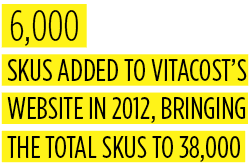David Zucker is a man who enjoys a challenge. His passion for health and analytics have served him well in his career, and outside the office, he’s a competitive triathlete. So when Vitacost.com needed to revamp its e-marketing strategies, Zucker was the man for the job. Now, as the company’s chief marketing officer, he is helping Vitacost set an example for both its customers and its peers. “I made the move to Vitacost because it fulfilled three requirements for me—it allows me to use my highly analytical background, it is an Internet company, and it is a company focused on health,” Zucker says. “Given all the options, it’s always easier to market when you are personally engaged in the products.” In an effort to brush up on our own competitive advantage, we pried Zucker for the strategies he’s used to put Vitacost on a path to e-success.
1. Ensure Your Fundamentals are Sound
“Before you can kick off a successful marketing strategy, you have to ensure that your approach, your team, and your processes are all in place,” Zucker says. One of his first challenges at Vitacost was revamping the marketing department’s approach, which included mentoring and directing the team’s talent, and changing the way the company viewed itself and its product. “Internally, we had to change the way we thought so we could move forward,” Zucker says.
2. Clarify Your Message
Before he came to Vitacost, Zucker says the company viewed itself as a vitamin retailer, and that’s how they were viewed by consumers as well. “We’ve changed our focus to being an online, discount, health-food store, which is really more appropriate for what we sell,” Zucker says. “Our tagline—take the cost out of healthy living—reflects this new focus.” Zucker also changed the company’s logo from a pill to a hand lifting the sun, a more appropriate visual for the new message.
3. Know What You Do Well
It can be easy to focus on the things that need improvement, but Zucker points out that it’s equally important to understand where you excel so you can maximize your advantages. “Vitacost.com has a great consumer proposition—we sell great products at a great price,” Zucker says. “In fact, our website is one of the top converting websites on the Internet—people come to the site, find what they want, and they buy. That position was a great place to start.”
4. Calibrate for the Medium
In the e-marketplace, visuals are extremely important to creating a comfortable consumer experience; however, Vitacost’s former site did not follow Internet best practices for design and usage. “Basically, we had to fundamentally change the entire site,” Zucker says. “We chose colors easier on the eyes, changed the overall navigation, and modified the pages to better showcase the products. Creative can have a huge impact on a consumer’s impression of a company, and we want our impression to be reputable.”
5. leverage the Power of Social Media
 With the basics firmly in place, Zucker launched a full-scale incorporation of social media, from a ramped up Facebook page to blogger interaction. Each page of the site now features a Facebook “Like” button alongside a Twitter link and Pinterest button. “By having these interactive elements, we can easily track the products that receive the most ‘Likes’ or ‘Pins,’ and, in turn, push efforts in these areas,” Zucker says. The company also has partnered with expert bloggers—including two professional triathletes and a successful cook—to review products and post about them on their blogs. “Every time one of our partners mentions a product from Vitacost, it’s
With the basics firmly in place, Zucker launched a full-scale incorporation of social media, from a ramped up Facebook page to blogger interaction. Each page of the site now features a Facebook “Like” button alongside a Twitter link and Pinterest button. “By having these interactive elements, we can easily track the products that receive the most ‘Likes’ or ‘Pins,’ and, in turn, push efforts in these areas,” Zucker says. The company also has partnered with expert bloggers—including two professional triathletes and a successful cook—to review products and post about them on their blogs. “Every time one of our partners mentions a product from Vitacost, it’s
seen by thousands of their followers—it’s great advertis-
ing,” Zucker says.
6. Elevate Consumer Interaction
One thing lacking for the Vitacost website was a way to engage consumers while providing education. As a result, the company is now aggressively producing short product videos to highlight the benefits in a fun way. “We’re able to measure every time a video is watched, and if a purchase is made as a result,” Zucker says. Best of all, Vitacost is able to produce the videos in-house, keeping costs quite low. “We’ve definitely seen an increase in sales with the addition of the videos,” Zucker says.
7. Grab Consumers on the Go
Mobile accessibility has allowed for Vitacost to engage with consumers regardless of device. The company has added apps for both the Android and iPhone, and is looking at an app for the iPad. “Mobile devices have become a huge shopping channel—people use them to comparison shop, check their e-mail for sales and other promotions, and to purchase, as well,” Zucker says.


